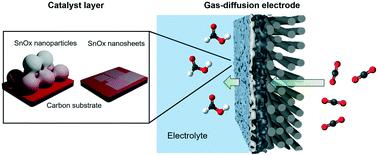当前位置:
X-MOL 学术
›
React. Chem. Eng.
›
论文详情
Our official English website, www.x-mol.net, welcomes your
feedback! (Note: you will need to create a separate account there.)
Unveiling the effects of dimensionality of tin oxide-derived catalysts on CO2 reduction by using gas-diffusion electrodes
Reaction Chemistry & Engineering ( IF 3.4 ) Pub Date : 2020-12-10 , DOI: 10.1039/d0re00396d Mengran Li 1, 2, 3, 4 , Mohamed Nazmi Idros 1, 2, 3, 4 , Yuming Wu 1, 2, 3, 4 , Sahil Garg 1, 2, 3, 4 , Shuai Gao 1, 2, 3, 4 , Rijia Lin 1, 2, 3, 4 , Hesamoddin Rabiee 2, 4, 5, 6 , Zhiheng Li 1, 2, 3, 4 , Lei Ge 1, 2, 3, 4, 7 , Thomas Edward Rufford 1, 2, 3, 4 , Zhonghua Zhu 1, 2, 3, 4 , Liye Li 8, 9, 10 , Geoff Wang 1, 2, 3, 4
Reaction Chemistry & Engineering ( IF 3.4 ) Pub Date : 2020-12-10 , DOI: 10.1039/d0re00396d Mengran Li 1, 2, 3, 4 , Mohamed Nazmi Idros 1, 2, 3, 4 , Yuming Wu 1, 2, 3, 4 , Sahil Garg 1, 2, 3, 4 , Shuai Gao 1, 2, 3, 4 , Rijia Lin 1, 2, 3, 4 , Hesamoddin Rabiee 2, 4, 5, 6 , Zhiheng Li 1, 2, 3, 4 , Lei Ge 1, 2, 3, 4, 7 , Thomas Edward Rufford 1, 2, 3, 4 , Zhonghua Zhu 1, 2, 3, 4 , Liye Li 8, 9, 10 , Geoff Wang 1, 2, 3, 4
Affiliation

|
We report the effects of catalyst dimensionality on electrochemical CO2 conversion to formate by comparing the performance of tin oxide-derived 3D nanoparticles and tin oxide-derived 2D nanosheets deposited on gas-diffusion electrodes. Our results indicated that an extensive interface between the catalyst and the electrode substrate could lower the surface tin oxidation states and the hydrophobicity of the catalyst layer during CO2 electrolysis at a current density over 100 mA cm−2. This catalyst–substrate interfacial effect provides the nanosheets with a large interface area to become more selective for CO2 electrochemical reduction but with a higher overpotential requirement as compared to the 3D nanoparticle catalysts with limited interfacial area. Consequently, the electrode with nanosheets as the catalyst achieved a partial current density of formate at 116 mA cm−2 at a cathode potential of −1.03 V versus reversible hydrogen electrode, which is equivalent to a formate production rate of 36 μmol min−1 cm−2. Our work here demonstrates the importance of the catalyst–substrate interface in determining the oxidation states and wettability at the catalyst surface and the ultimate performance of the gas-diffusion electrode. These findings also have potential to guide the design of a catalyst–substrate to advance other important electrochemical processes such as fuel cells and water splitting.
中文翻译:

通过使用气体扩散电极揭示了氧化锡衍生催化剂的尺寸对CO2还原的影响
我们通过比较沉积在气体扩散电极上的氧化锡衍生的3D纳米颗粒和氧化锡衍生的2D纳米片的性能,报告了催化剂尺寸对电化学CO 2转化为甲酸的影响。我们的结果表明,在电流密度超过100 mA cm -2的条件下,CO 2电解过程中,催化剂与电极基底之间的广泛界面会降低表面锡的氧化态和催化剂层的疏水性。这种催化剂-底物的界面效应为纳米片提供了较大的界面面积,使其对CO 2的选择性更高。与具有有限界面面积的3D纳米颗粒催化剂相比,电化学还原具有更高的超电势要求。因此,与可逆氢电极相比,具有纳米片作为催化剂的电极在阴极电流为-1.03 V时,在116 mA cm -2处甲酸的部分电流密度为36μmolmin -1 cm −2。我们在这里的工作证明了催化剂-底物界面在确定催化剂表面的氧化态和润湿性以及气体扩散电极的最终性能方面的重要性。这些发现也有可能指导催化剂底物的设计,以推进其他重要的电化学过程,例如燃料电池和水分解。
更新日期:2020-12-23
中文翻译:

通过使用气体扩散电极揭示了氧化锡衍生催化剂的尺寸对CO2还原的影响
我们通过比较沉积在气体扩散电极上的氧化锡衍生的3D纳米颗粒和氧化锡衍生的2D纳米片的性能,报告了催化剂尺寸对电化学CO 2转化为甲酸的影响。我们的结果表明,在电流密度超过100 mA cm -2的条件下,CO 2电解过程中,催化剂与电极基底之间的广泛界面会降低表面锡的氧化态和催化剂层的疏水性。这种催化剂-底物的界面效应为纳米片提供了较大的界面面积,使其对CO 2的选择性更高。与具有有限界面面积的3D纳米颗粒催化剂相比,电化学还原具有更高的超电势要求。因此,与可逆氢电极相比,具有纳米片作为催化剂的电极在阴极电流为-1.03 V时,在116 mA cm -2处甲酸的部分电流密度为36μmolmin -1 cm −2。我们在这里的工作证明了催化剂-底物界面在确定催化剂表面的氧化态和润湿性以及气体扩散电极的最终性能方面的重要性。这些发现也有可能指导催化剂底物的设计,以推进其他重要的电化学过程,例如燃料电池和水分解。









































 京公网安备 11010802027423号
京公网安备 11010802027423号